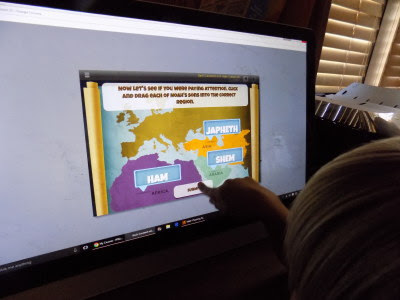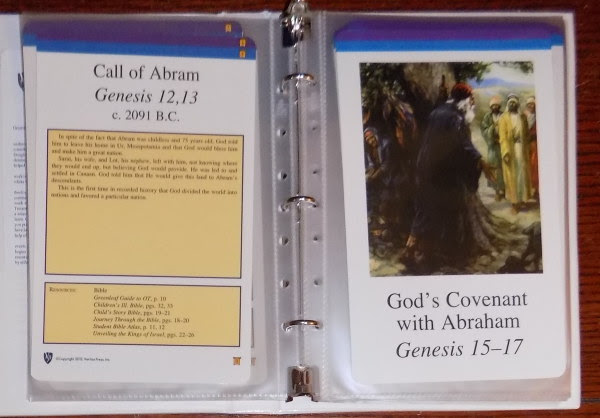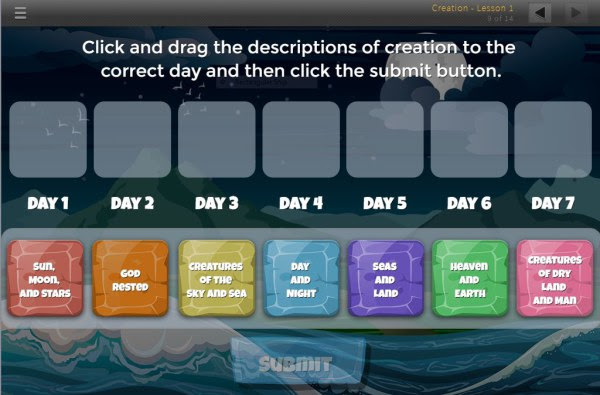
When I first started this blog most of my posts were about the Bible lessons I started doing when my oldest turned three as I sought to be intentional about discipling him. Now he’s just starting 1st grade (and there are two preschoolers and a baby coming up close behind!), and I would still say the most important part of my children’s home education is our time in God’s Word. I have several goals:
- I want them to know about the Bible (historical context, authors, genres, canonization, etc.).
- I want them to know what’s in it (where to find what they’re looking for).
- I want it to be a part of their daily lives in such a way that when they are grown they can’t imagine a day passing without being in the Word because they are eager for God to speak to them through it.
So how do I go about pursuing those goals on a day to day basis? We spend time each morning in Proverbs, and time each evening in family devotions, both times helping meet the last two goals. But now that Ian is starting 1st grade, I want a thorough, systematic way to help us meet the first one. That’s why I was SO excited to find Bible Road Trip.
What is it?
 Bible Road Trip is a 3-year curriculum design to be used over and over as a child matures from preschool all the way through high school. (I love repeatable cycles!) It takes students on a journey from Genesis to Revelation, teaching about each book and helping them come to a greater understanding of the overall message of the Bible.
Bible Road Trip is a 3-year curriculum design to be used over and over as a child matures from preschool all the way through high school. (I love repeatable cycles!) It takes students on a journey from Genesis to Revelation, teaching about each book and helping them come to a greater understanding of the overall message of the Bible.
I have many friends who limit their homeschool Bible time to the ties they can make between the Scriptures and whatever else they are studying. While I think that is an important part of educating and discipling our children, I also think it is essential to have a time devoted specifically to studying the Bible on a systematic basis. I thought I was going to have to create my own program to take my children through the Bible the way I desired, but Danika Cooley, the author of Bible Road Trip, has put together a curriculum that leads students through God’s Word, helping them understand what they are reading.
The program is broken up into three 32-week years, making it easy to fit into a school year with flexibility for holidays, time to catch up, or extended study:
- Year One covers the Old Testament books of Law and History
- Year Two covers the Old Testament books of Poetry and Prophecy
- Year Three covers the entire New Testament.
There are 5 separate levels of study, following essentially classical delineations:
- Preschool-Kindergarten
- Lower Grammar (Grades 1-3)
- Upper Grammar (Grades 4-6)
- Dialectic (Grades 7-9)
- Rhetoric (Grades 9-12)
For each week of study, there are assignments at each of these levels, so the entire family can be focusing on the same portion of Scripture simultaneously in ways developmentally appropriate to each students stage of learning.
Each week is broken up into two main sections. “Dig Deep” contains the bulk of the lesson:
- Researching the Word (using the Bible study books listed below)
- Reading the Word (5 daily assignments including a few comprehension questions)
- Memorizing the Word (weekly memory verse)
- Notebooking about the Word
- Praying about the Word (focusing on different countries around the world)
This is followed by a section for “Explore Further,” which includes:
- Learning More about the Word (related videos, etc.)
- Crafting Through the Word (hands-on projects to help reinforce what was learned)
Getting Started
Since Ian is in 1st grade, I’ll just be discussing how to use the program in the “Lower Grammar” stage. Here’s what we needed to collect in order to begin using Bible Road Trip:
 There are also a few recommended resources for extra learning:
There are also a few recommended resources for extra learning:
 Our Experience
Our Experience
We spent some time on Week 1 and 2 of Year One, which cover “What is the Bible?” and “Exploring the Old Testament,” but then we jumped ahead because I want to use Bible Road Trip to enrich the boys’ study as we finish going through the Bible in our family devotions. (We started in August 2012 and are just about finished with the Old Testament period in our chronological study.) After those introductory weeks, we skipped ahead to Year Two to find the sections on Daniel so we be “on the same page,” and then we went back to Year One to finish the story of the exiles’ return in Ezra and Nehemiah.
Year Three will soon begin being posted week by week, and that’s what we plan to use for this coming school year as we head into the New Testament as a family.
What We Liked About Bible Road Trip
I like that Danika has created the program as an adaptable tool for families. “The goal is to acquaint our children with the Word of God, not to create busy work.” If the suggestions she makes for each lesson aren’t helpful, it’s not going to cause problems if you decide to skip them with your family. On the other hand, she provides some wonderful ways to engage children, especially in the “Explore Further” section of each lesson.
 I think my favorite part of the curriculum, however, is the Notebooking Journal. The pages Danika has created are just stunning! They contain many full-color works of art from masters such as Van Gogh, Michelangelo, and Rembrandt. Notebooking is such a great learning tool, and these pages are going to create a beautiful record of what we have learned. Ian loves going through the Bible notebook we created during his preschool years, and I know this will be something he goes back to again and again.
I think my favorite part of the curriculum, however, is the Notebooking Journal. The pages Danika has created are just stunning! They contain many full-color works of art from masters such as Van Gogh, Michelangelo, and Rembrandt. Notebooking is such a great learning tool, and these pages are going to create a beautiful record of what we have learned. Ian loves going through the Bible notebook we created during his preschool years, and I know this will be something he goes back to again and again.
(Incidentally, I first heard about Bible Road Trip when I purchased a lifetime membership to notebookingpages.com and received the Year One lesson plan pdf as a bonus. If you want to find out more about the benefits of notebooking, their website is a great place to start!)
What We Adjusted for Our Family
When going through the Bible I always have to make a decision about how I’m going to do it: book by book or chronological order? There are pros and cons to both approaches, and those are passed on when choosing a Bible curriculum.
We have been using a devotional that goes through chronologically, which I think really helps kids grasp the flow of history and see where the different stories they read in the Bible fit into the big picture. Bible Road Trip goes through book by book, so while you get a good sense of history in Year One, you miss a few things (like the stories of Daniel) that are described in the books of prophecy in Year Two. As I said above, we solved this issue by using the appropriate lessons from the Year Two curriculum since we already have a chronological framework established. When I begin the entire 3-year cycle again, I will probably just do Bible Road Trip as written, but I’m wondering if there will be some confusion with abandoning the chronological approach.
I also opted not to use the “Praying About the Word” section. It’s not that I had any issues with it; on the contrary, I thought it was a valuable addition. Still, it seemed to be completely separate from rest of the study, which made it feel like a supplementary curriculum in and of itself. We just are doing so much already that I decided to hold off on it, at least for now.
Just the Facts
Interested in starting Bible Road Trip? Here’s
- Recommended ages: preschool-highschool
- Weekly lessons plans and notebooking pages are available for free if you download each week separately!
- If you want the convenience of having the whole year in one place (great for printing the year in advance with one click!), you can purchase the Year One and
Year Two lesson plans ($20 per year) and the corresponding Notebooking Journals ($20 per year for each level: Lower Grammar, Upper Grammar, or Dialectic) as pdf files.
My Overall Impression
I’m excited to find such a valuable tool to help disciple my children. I am so thankful for the research Danika has put into Bible Road Trip and the time she has taken in making it available for other families to use. I’m sure I’ll be sharing more as we get further into our journey!

DISCLAIMER: I received the Year One Notebooking Journal for free in exchange for my honest review. I was not required to write a positive review, nor was I compensated in any other way. All opinions I have expressed are my own or those of my family. I am disclosing this in accordance with the FTC Regulations. This post contains affiliate links.








 Because Ian went through one of the Veritas Press history courses last year, Elijah went into this course with certain expectations. Some things were the same, but there were also several differences. His favorite thing about the history lessons had been the games. He watched Ian get to play a new one every week and was so excited to start his own course so he could play games like that too. Unfortunately, for the first several weeks there were no games. He was really disappointed, and it was hard to get him motivated to sign on and do his Bible lesson.
Because Ian went through one of the Veritas Press history courses last year, Elijah went into this course with certain expectations. Some things were the same, but there were also several differences. His favorite thing about the history lessons had been the games. He watched Ian get to play a new one every week and was so excited to start his own course so he could play games like that too. Unfortunately, for the first several weeks there were no games. He was really disappointed, and it was hard to get him motivated to sign on and do his Bible lesson.




 I’ve recently begun checking out various devotional books to use with my children. I wasn’t quite sure what I was looking for (or what was out there), so I wanted to explore several options. My most recent opportunity came with a chance to review
I’ve recently begun checking out various devotional books to use with my children. I wasn’t quite sure what I was looking for (or what was out there), so I wanted to explore several options. My most recent opportunity came with a chance to review 























 Wars of Humanity
Wars of Humanity The story of Joseph is found in most children’s Bible storybooks. We read it in several over the weeks we spent on the story, but I also really liked this book:
The story of Joseph is found in most children’s Bible storybooks. We read it in several over the weeks we spent on the story, but I also really liked this book: 


